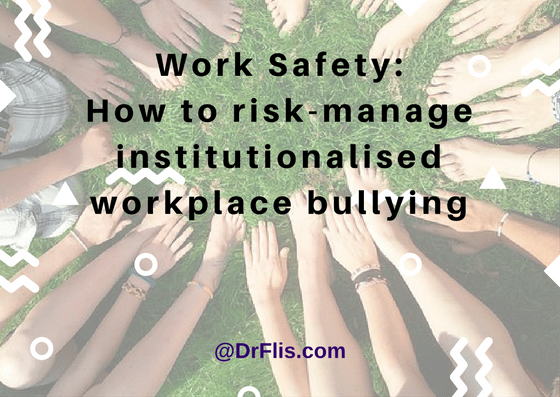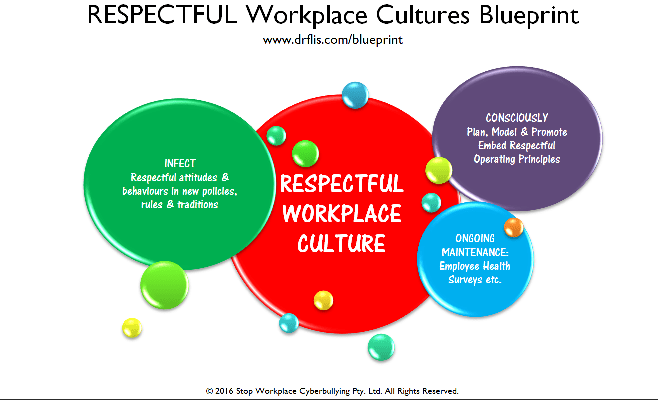
By Dr Felicity Lawrence
Most people reading this article probably already suspect bully-free workplaces have a higher than average chance of fostering safer, more innovative and productive environments. Researchers have found that people working in safe, respectful environments are more empowered to report potential issues or faults, as they know they are valued. Safer workplaces enhance engagement given there’s less danger of being vilified for taking the occasional rational risk. Risks and mistakes enable learning, transformative thinking and innovation. Yet, one of the most fraught questions I often hear is, ‘How in the world do generally well-meaning private or public workplaces create institutionalise bullying?’ Despite all the research about the causes of workplace bullying (e.g., cultural, societal, personalities, constant change, confusion of roles and responsibilities) the answer to this question is surprisingly simple.
Workplace bullying becomes institutionalised when it is ignored or disregarded by workplace leaders who justify the acts as reasonable and ‘how we get things done around here.’ Bullying or cyberbullying are not reasonable behaviours. However, the potential for confusion between bullying/cyberbullying and reasonable work requests and behaviours can be significant. To alleviate ongoing confusion I’ve created a free checklist listing overt and covert bullying and cyberbullying, together with best practice techniques to make reasonable work requests (Einarsen, Hoel, Zapf, & Cooper, 2011; Jenkins, 2013; Namie & Namie, 2010). Note that reasonable work behaviours must be considered within the context of your work and social culture.

Consciously or unconsciously, we all recruit or promote people with similar attitudes and behaviours as ourselves, so leaders who accept ‘the end justifies the means’ will likely recruit or promote similarly minded people. Before you know it, disrespectful attitudes and behaviours are embedded into workplace policies, process and other control-mechanisms. Tehrani (2012) describes this as a context where employees feel powerless and systematically abused over an extended period of time.
Yet, it is possible to risk manage institutionalised bullying. To do so, however, requires giving everyone in the workplace the opportunity to co-develop ‘respectful workplace’ operating principles. These operating principles then inform the workplace’s governing social policies, performance and recruitment guidelines and processes plus managerial and employee training and so on.
Eight interventions to risk manage institutionalised bullying
According to my Respectful Workplace Cultures Blueprint, eight interventions are necessary to risk manage institutionalised bullying:
1. Conduct an organisation assessment of the work costs attributed to offline and online bullying;
2. Obtain executive and management commitment to a respectful work culture;
3. Create a whole-of-workplace co-developed social contract that articulates what people expect of one another in the workplace;
4. Diagnose the psychosocial risks of bullying and cyberbullying to shape an anti-bullying policy;
5. Shape an integrative approach that includes preventive interventions at both individual, team and organisation-wide levels (e.g., integrate early stage conflict resolution and complaint management systems);
6. Implement the respectful social contract (with anti-bullying policy) through organisation-wide strategic and tactical action planning:
7. Embed the respectful culture and behaviours through consistent, ongoing and clear communication and training; and
8. Evaluate and re-tune as needed.
The Safety Conversation Podcast: Listen now!
The Safety Conversation with SHP (previously the Safety and Health Podcast) aims to bring you the latest news, insights and legislation updates in the form of interviews, discussions and panel debates from leading figures within the profession.
Find us on Apple Podcasts, Spotify and Google Podcasts, subscribe and join the conversation today!




Yeah, marvelous, terrific, cracking stuff, an essential for every good employer looking to conserve, restore and even energise as well as add value to the primary assets of the business let alone foster sustainable performance and productivity over the working life-cycle of it’s human resources. Just remain curious how one can bridge the huge mind the gap between Professional PC and far from PC Personal Ideologies of far too many absolutely “on message when talking the talk” but, sort of, soooo lethargic even “seriously resistant when it come to walking the walk” ? A toxic employee is one thing but,… Read more »
[…] MORE >>> […]
In 2014 I made a suggestion of coin the term of ‘corporate harassment’ to our provincial government, which has not been widely accepted. Thus I am glad to see your term of ‘institutionalized bullying’. Given the power of hierarchies of an ‘institution’, the damage of bullying is amplified. It’s paramount to spread the idea into business / corporation / institutional world by promoting it to business associations and HR organizations at national level. Hope to see it attracts more attention after the harm (to ‘bottom line’, business brand and staff retention) of workplace harassment became more and more obvious. Jenny… Read more »